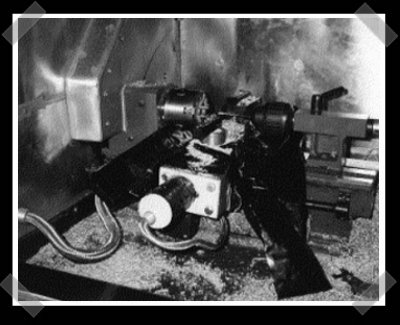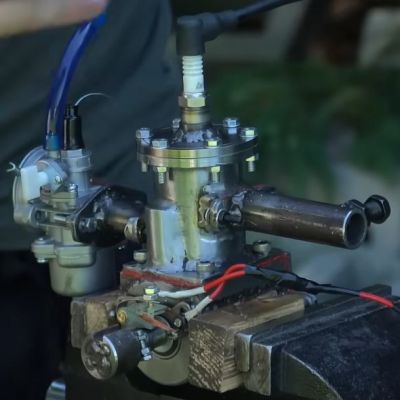
Given my obsession of CNC projects, I’m surprised that we haven’t mentioned this project before. [Dave] put together an excellent site about his CNC converted mini-lathe. (The same on that I’ve got) He built a pretty simple stepper controller to drive it. Since the lathe only needed two axis motors, he drove the steppers with some mosfets that he triggered from a parallel port. The site has been around for a while, but I thought you guys would enjoy a classic hack like this one.
Foam Cutting Lathe

shbazjinkens had originally linked to Dan’s workshop when commenting on the backyard aluminum foundry. Dan uses a lost foam technique for casting his parts: the foam burns out of the mold to be replaced by metal. To make the initial foam pieces he built this hot wire based foam cutting lathe (out of cast parts natch). Nice little specialized tool that you definitely wouldn’t find easily. Dan is also responsible for the hot air pencil we mentioned the other day. Needless to say, there is a lot of good stuff on his site so have a look around.
This Tiny Steam Engine Takes A Watchmaker’s Skill To Build
When your steam engine build requires multiple microscopes, including those of the scanning electron variety, you know you’re building something really, really tiny.
All of the usual tiny superlatives and comparisons apply to [Chronova Engineering]’s latest effort — fits on a pencil eraser, don’t sneeze while you’re working on it or you’ll never find it. If we were to put the footprint of this engine into SMD context, we’d say it’s around a 2010 or so. As one would expect, the design is minimalistic, with no room for traditional bearings or valves. The piston and connecting rod are one piece, meaning the cylinder must pivot, which provides a clever way of switching between intake and exhaust. Tiny crankshaft, tiny flywheel. Everything you’d associate with a steam engine is there, but just barely.
The tooling needed to accomplish this feat is pretty impressive too. [Chronova] are no strangers to precision work, but this is a step beyond. Almost everything was done on a watchmaker’s lathe with a milling attachment and a microscope assist. For the main body of the engine, a pantograph engraving machine was enlisted to scale a 3D printed template down tenfold. Drill bits in the 0.3 mm range didn’t fare too well against annealed tool steel, which is where the scanning electron microscope came into play. It revealed brittle fractures in the carbide tool, which prompted a dive down the rabbit hole of micro-machining and a switch to high-speed steel tooling.
It all worked in the end, enough so that the engine managed 42,000 RPM on a test with compressed air. We eagerly await the equally tiny boiler for a live steam test.
Continue reading “This Tiny Steam Engine Takes A Watchmaker’s Skill To Build”
A Two-Stroke Engine Made From Scratch Using Basic Hardware Store Parts

How hard could it to be to build a two-stroke internal combustion engine (ICE) from scratch? This is a challenge that [Camden Bowen] gladly set for himself, while foregoing such obvious wastes of time like first doing an in-depth literature study on the topic. That said, he did do some research and made the design in OnShape CAD before making his way over to the hardware store to make some purchases.
As it turns out, you can indeed build a two-stroke engine from scratch, using little more than some metal piping and other parts from the hardware store. You also need a welder and a lathe, with [Camden] using a Vevor mini-lathe that totally puts the ‘precision’ in ‘chatter’. As building an ICE requires a number of relatively basic parts that have to move with very little friction and with tight tolerances, this posed some challenges, but nothing that some DIY spirit can’t fix.
In the case of the very flexible boring bar on the lathe, improvising with some sturdy metal stock welded to a short boring bar resolved that, and precision was achieved. Together with an angle grinder, [Camden] was then able to manufacture the crank case, the cylinder and crank shaft and all the other pieces that make up an ICE. For the carburetor he used a unit off Amazon, which turned out to have the wrong throat size at 19 mm, but a 13 mm version worked. Ultimately, the first ICE constructed this way got destroyed mostly by running it dry and having the starter fluid acting as a solvent, but a full rebuild fixed all the issues.
This second attempt actually ran just fine the first time around, with oil in the crank case so that the poor engine wasn’t running dry any more. With a 40:1 fuel/oil mixture the little engine idles and runs as well as a two-stroke can, belching blue smoke and making a ruckus. This answers the question of whether you can build a two-stroke ICE with basic machining skills and tools, but of course the question that’s now on everyone’s lips is whether a four-stroke one would be nearly as ‘easy’. We wait with bated breath.
Continue reading “A Two-Stroke Engine Made From Scratch Using Basic Hardware Store Parts”
The Mysterious Roman Dodecahedron Was Possibly Just For Knitting
Over the years archaeological digs of Roman sites have uncovered many of these strange dodecahedrons, usually made out of metal and with various holes in their faces. With no surviving records that describe how they were used, speculation has ranged from jewelry to a knitting aid. In a 2023 video by [Amy Gaines] it is this latter use which is explored, using a 3D printed dodecahedron and some wooden dowels to knit both gold wire and yarn into rather intricate patterns that are also referred to as ‘Viking Knitting’.
As we mentioned previously when yet another one of these dodecahedrons was uncovered, their use was unlikely to be of supreme relevance in military or scientific circles on account of a lack of evidence. What is quite possible is that these were both attractive shapes for jewelry (beads), and useful knitting aids for both jewelry makers (for e.g. gold wire braiding) and quite possibly yarn-related uses. The results which [Amy] demonstrates in the video for the gold wire in particular bear a striking resemblance to ancient braided gold chains on display at the Met and other museums, which leads credence to this theory.
If these items were effectively just common knitting tools, that would explain why the historical record is mum on them, as they would have been as notable as a hammer or a precision lathe used by the ancient Greeks.
Thanks to [john] for the tip.
Continue reading “The Mysterious Roman Dodecahedron Was Possibly Just For Knitting”
DIY Spacer Increases FDM Flow Rate For Faster, Better Printing
The host of problems to deal with when you’re feeling the need for FDM speed are many and varied, but high on the list is figuring out how to melt filament fast enough to accommodate high flow rates. Plus, the filament must be melted completely; a melty outside and a crunchy inside might be good for snacks, but not for 3D printing. Luckily, budget-minded hobbyists can build a drop-in booster to increase volumetric flow using only basic tools and materials.
[aamott]’s booster, which started life as a copper screw, is designed to replace the standard spacer in an extruder, with a bore that narrows as the filament gets closer to the nozzle to ensure that the core of the filament melts completely. Rather than a lathe, [aamott]’s main tool is a drill press, which he used to drill a 0.7 mm bore through the screw using a PCB drill bit. The hole was reamed out with a 10° CNC engraving bit, generating the required taper. After cutting off the head of the screw and cleaning up the faces, he cut radial slots into the body of the booster by threading the blade of a jeweler’s saw into the bore. The result was a bore wide enough to accept the filament on one end, narrowing to a (roughly) cross-shaped profile at the other.
Stacked up with a couple of knock-off Bondtech CHT nozzles, the effect of the booster was impressive — a 50% increase in flow rate. It’s not bad for a prototype made with simple tools, and it looks a little easier to build than [Stefan]’s take on the same idea.
Continue reading “DIY Spacer Increases FDM Flow Rate For Faster, Better Printing”
Tech In Plain Sight: Theodolites
We take it for granted that you can look at your phone and tell exactly where you are. At least, as exact as the GPS satellites will allow. But throughout human history, there has been a tremendous desire to know where here is, exactly. Where does my farm end and yours start? Where is the border of my city or country? Suppose you have a flagpole directly in the center of town and a clock tower at the edge of town. You know where they are precisely on a map. You also know how tall they are. What you need is a theodolite, which is an instrument that measures angles very precisely.
















